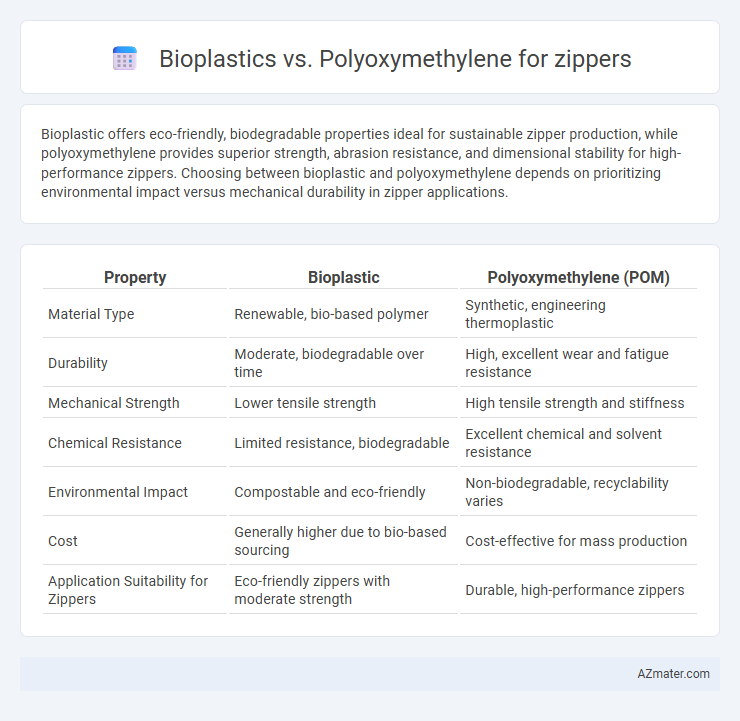Bioplastic offers eco-friendly, biodegradable properties ideal for sustainable zipper production, while polyoxymethylene provides superior strength, abrasion resistance, and dimensional stability for high-performance zippers. Choosing between bioplastic and polyoxymethylene depends on prioritizing environmental impact versus mechanical durability in zipper applications.
Table of Comparison
| Property | Bioplastic | Polyoxymethylene (POM) |
|---|---|---|
| Material Type | Renewable, bio-based polymer | Synthetic, engineering thermoplastic |
| Durability | Moderate, biodegradable over time | High, excellent wear and fatigue resistance |
| Mechanical Strength | Lower tensile strength | High tensile strength and stiffness |
| Chemical Resistance | Limited resistance, biodegradable | Excellent chemical and solvent resistance |
| Environmental Impact | Compostable and eco-friendly | Non-biodegradable, recyclability varies |
| Cost | Generally higher due to bio-based sourcing | Cost-effective for mass production |
| Application Suitability for Zippers | Eco-friendly zippers with moderate strength | Durable, high-performance zippers |
Introduction to Bioplastic and Polyoxymethylene in Zipper Manufacturing
Bioplastic, derived from renewable biomass sources, offers biodegradability and reduced environmental impact in zipper manufacturing, contrasting with polyoxymethylene (POM), a synthetic polymer known for its high strength, stiffness, and chemical resistance. Polyoxymethylene is commonly used in zipper components due to its durability and precise molding capabilities, ensuring smooth functionality and longevity. The choice between bioplastic and POM in zipper production depends on balancing sustainability goals with mechanical performance requirements.
Material Properties: Bioplastic vs Polyoxymethylene
Bioplastic offers biodegradability and reduced environmental impact, with moderate mechanical strength and flexibility suitable for eco-friendly zipper applications. Polyoxymethylene (POM) excels in high tensile strength, stiffness, and excellent wear resistance, making it ideal for durable, high-performance zippers requiring long-term reliability. The thermal stability of POM surpasses bioplastics, supporting applications exposed to varying temperatures, while bioplastics prioritize sustainability with lower carbon footprints.
Environmental Impact of Bioplastic and Polyoxymethylene Zippers
Bioplastic zippers significantly reduce environmental impact by being derived from renewable resources and offering biodegradability, which minimizes plastic pollution and landfill waste. Polyoxymethylene (POM) zippers, made from non-renewable petroleum-based polymers, are durable but have limited biodegradability and contribute to microplastic pollution. Choosing bioplastic zippers supports sustainability goals by lowering carbon footprints and enhancing end-of-life disposal options compared to conventional POM zippers.
Durability and Strength Comparison
Bioplastic zippers offer eco-friendly benefits but generally have lower durability and tensile strength compared to polyoxymethylene (POM) zippers, which exhibit superior mechanical performance and resistance to wear and impact. POM zippers maintain structural integrity under repeated stress and temperature variations, making them ideal for demanding applications requiring long-lasting reliability. The high crystallinity and stiffness of POM polymers ensure enhanced dimensional stability and resistance to deformation, outperforming typical bioplastic alternatives in strength metrics.
Cost Analysis for Zipper Production
Bioplastic zippers typically incur higher raw material costs compared to polyoxymethylene (POM), which remains a cost-effective choice due to its mass production and established supply chain. Manufacturing bioplastic zippers also demands adjustments in processing equipment and conditions, potentially increasing production expenses. However, the long-term environmental benefits of bioplastic materials may offset initial cost differences as regulatory pressures and consumer demand for sustainable products grow.
Design Flexibility and Aesthetic Options
Bioplastics offer enhanced design flexibility for zippers due to their ability to be easily molded into complex shapes and customized colors, catering to diverse aesthetic requirements. Polyoxymethylene (POM) provides high durability and smooth surface finish but has more limited color options and design adaptability compared to bioplastics. The choice between bioplastic and POM impacts zipper appearance and design innovation, with bioplastics enabling eco-friendly, visually appealing solutions.
Biodegradability and End-of-Life Disposal
Bioplastic zippers offer significant advantages in biodegradability compared to polyoxymethylene (POM), as they can break down naturally in composting environments within months, reducing landfill accumulation. Polyoxymethylene, a durable synthetic polymer, lacks inherent biodegradability, leading to persistence in the environment and challenges in recycling or disposal. End-of-life disposal for bioplastic zippers aligns with eco-friendly waste management practices, including industrial composting, while POM zippers often require incineration or specialized recycling, contributing to higher environmental impact.
Consumer Preferences and Market Trends
Consumer preferences for zippers increasingly favor bioplastics due to their environmental benefits, such as biodegradability and reduced carbon footprint, aligning with the growing demand for sustainable fashion. Polyoxymethylene (POM), known for its high strength, durability, and low friction, remains popular in high-performance applications despite concerns over its petroleum-based origin and limited recyclability. Market trends indicate a rising shift towards bioplastic zippers in eco-conscious brands, while POM continues to dominate in sectors prioritizing mechanical performance and longevity.
Industrial Applications and Performance
Bioplastic zippers offer eco-friendly advantages with biodegradability and reduced carbon footprint, making them suitable for sustainable packaging and garment industries. Polyoxymethylene (POM) zippers excel in industrial applications requiring high mechanical strength, chemical resistance, and dimensional stability such as automotive, aerospace, and heavy-duty outdoor gear. Performance-wise, POM ensures durability and low friction, while bioplastic zippers prioritize environmental impact without compromising moderate functional reliability in less demanding contexts.
Future Prospects in Zipper Material Innovation
Bioplastic exhibits promising future prospects in zipper material innovation due to its biodegradability and reduced environmental impact, aligning with growing sustainability demands in the fashion and packaging industries. Polyoxymethylene (POM) remains valued for its superior mechanical strength, wear resistance, and low friction properties, making it a benchmark for high-performance zippers in heavy-duty applications. Ongoing advances in bio-based polymer blends and enhanced processing techniques may bridge performance gaps, positioning bioplastics as a viable alternative to POM in the next generation of eco-friendly, durable zipper components.

Infographic: Bioplastic vs Polyoxymethylene for Zipper
 azmater.com
azmater.com